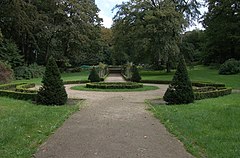Lindenstrasse (Bremen)
| Lindenstrasse | |
|---|---|
| Street in Bremen | |
| Vegesack 1860, left Fehr with the Chaussee, the later Lindenstrasse | |
| Basic data | |
| city | Bremen |
| district | Vegesack |
| Created | middle Ages |
| Cross streets | Fährgrund, Schulkenstrasse, Lemwerderstrasse, Fährer Flur, Otto-Friese-Strasse, Vereinsstrasse, Alter Schulweg, Hohe Feld, Fröbelstrasse, Am Lobbendorfer Pohl, Am Werfttor, Löhstrasse, An der Lobbendorfer Mühle, Kirchhofstrasse, Margaretenallee |
| use | |
| User groups | Cars, bikes and pedestrians |
| Road design | two lane road |
| Technical specifications | |
| Street length | 1300 meters |
The Linde road is a through and access road in Bremen , district of Vegesack , district ferry Lobbendorf . It leads in an east-west direction from Gerhard-Rohlfs-Straße / Fährgrund to Landrat-Christians-Straße in Blumenthal .
The cross streets and connecting streets were named u. a. as Gerhard-Rohlfs-Straße after the Africa explorer and writer Gerhard Rohlfs (1831-1896), Fährgrund after a corridor that leads into a valley to the ferry, Schulkenstraße after a family name, Lemwerderstraße after the place, Fährer Corridor after a field name , Otto- Friese-Straße 1952 after the unionist and Nazi persecuted (1886-1947), Vereinsstraße after the local clubs, Alter Schulweg, Hohe Feld after a field name, Fröbelstraße after the pedagogue Friedrich Fröbel (1782-1852), Am Lobbendorfer Pohl after the shallow lake ( ndt. = Pohl ), At the shipyard gate in front of the Bremer Vulkan shipyard , Löhstraße after a wood (ndt. = Lö or Löh ), At the Lobbendorfer Mühle after the mill from 1891 to 1937 (burnt down), unnamed path, Kirchhofstraße after the location on Friedhof, unnamed path, Margaretenallee after the first name of the gardener's mother Schnirring and Landrat-Christians-Straße 1952 after the teacher and district administrator Ludwig Christians (1875–1940); otherwise see the link to the streets.
history
Surname
The Lindenstrasse was named after the Linden ( Tilia ), a tree that can reach an age of up to 1000 years and a height of up to 40 meters. The street was previously called Chaussee.
development
Fähr (formerly Vehr or Fehr ) with a Weser ferry was settled since the 16th century and in 1855 had 613 inhabitants. Lobbendorf was mentioned in 1139 as Lobbenthorpe . In 1939 both communities were connected to Bremen and in 1946 together a district of Vegesack.
Wätjen's estate was created by shipowner Diedrich Heinrich Wätjen from 1830 . His son expanded the property considerably. In 1900, Wätjens Park was opened to the public and then sold to the Bremer Vulkan, which used parts of the area for industrial purposes. The cemetery was built in 1876. In the 20th century, the eastern part of the avenue developed into a lively shopping street.
traffic
The road was the old road to Blumenthal.
In transport in Bremen bus lines run through 91 and 92 (Gröpelingen ↔ Rönnebeck) and 94 (Marßel ↔ Bf Castle ↔ Schwanewede) the road.
Buildings and facilities
On the tree-lined street there are mainly two to three-story residential and commercial buildings.
Notable buildings and facilities
- Fährgrund Nr. 16/18: Kombibad Bremen-Nord from 1963, from 1989 after renovation sports and leisure pool Fritz-Piaskowski , later named Freizeitbad Vegesack , renovated in 2006.
- No. 1a: 6-gesch. newer high-rise office building as a corner building
- No. 1d to 3: Two 3-fold newer clinkered residential and commercial buildings with gable elements
- No. 6/8: 3-ply newer gabled houses as commercial and office buildings
- No. 10 / 10a: 2-sch. Residential and commercial building with a mansard roof , probably from the 1920 / 30s with the rose pharmacy
- Ferry corridor No. 15: 2-sch. Elementary school Fährer corridor
- No. 28: 2-sch. Residential and commercial building from around 1900
- No. 32: 1-sch. Residential and commercial building with a mansard roof
- No. 38: 2-sch. brick-built residential and commercial building from the 1900s
- No. 57: 1-sch. Gabled house from around 1900
- No. 61: 2-sch. brick-built residential and commercial building from around 1900
- No. 69: 1-sch. Residential and commercial building from 1892 with decorated 2-storey. Gable risalit
- No. 71: 3-sch. Residential and office building with the Lower Saxony - Bremen family fund and a green forecourt
- Between Fröbelstraße and Am Werfttor: green area
- Between No. 91 to 95: 1.7 hectare Evangelical cemetery Vegesack Lindenstraße (Kirchhofstraße 39) from 1876 with the graves of many shipowners, shipbuilders, captains and others, etc. a. Johann Lange , Bernhard Schröder, Gerhard Rohlfs , Ernst Georg Baars , Oltmann Jaburg and Friedrich Rohr . Chapel from 1930 based on plans by Ernst Becker-Sassenhof . The sculptor Arnold Hermann Lossow created a preserved tomb for the shipowner Johann Lange out of white marble.
- From No. 104 south: Wätjens Park , also Wätjens estate owned by the merchant and shipowner Diedrich Heinrich Wätjen (1785–1858), who purchased the property in 1830 and created a rural summer residence and had the country house built in a classicist style. His son Christian Heinrich Wätjen expanded the property considerably. In 1900 the park was opened to the public and then sold to the Bremer Vulkan, which used parts of the area for industrial purposes.
- No. 101: 2nd floor House from around 1900
- No. 110: Bremen branch of the Federal Office for Migration and Refugees (BAMF) since 2016
See also
literature
- Herbert Black Forest : The Great Bremen Lexicon. 2nd, expanded and updated edition. In two volumes. Edition Temmen , Bremen 2003, ISBN 3-86108-693-X (first edition: 2002, supplementary volume A – Z). 2008, ISBN 978-3-86108-986-5 .
- Monika Porsch: Bremer Straßenlexikon , complete edition. Schünemann, Bremen 2003, ISBN 3-7961-1850-X .
Coordinates: 53 ° 10 ′ 37.5 ″ N , 8 ° 36 ′ 11.6 ″ E

